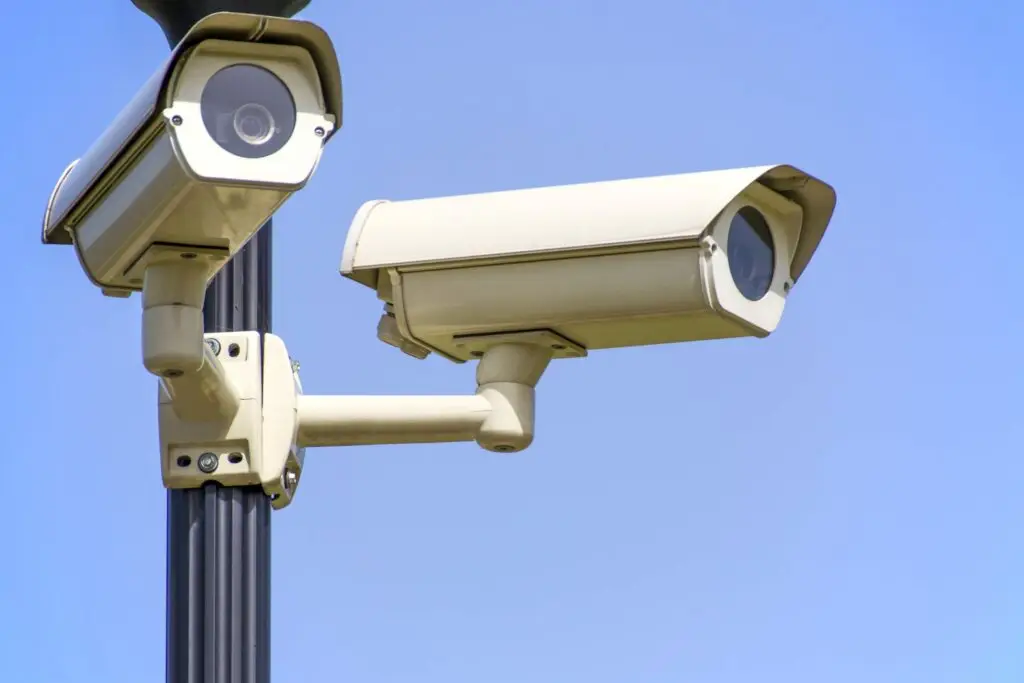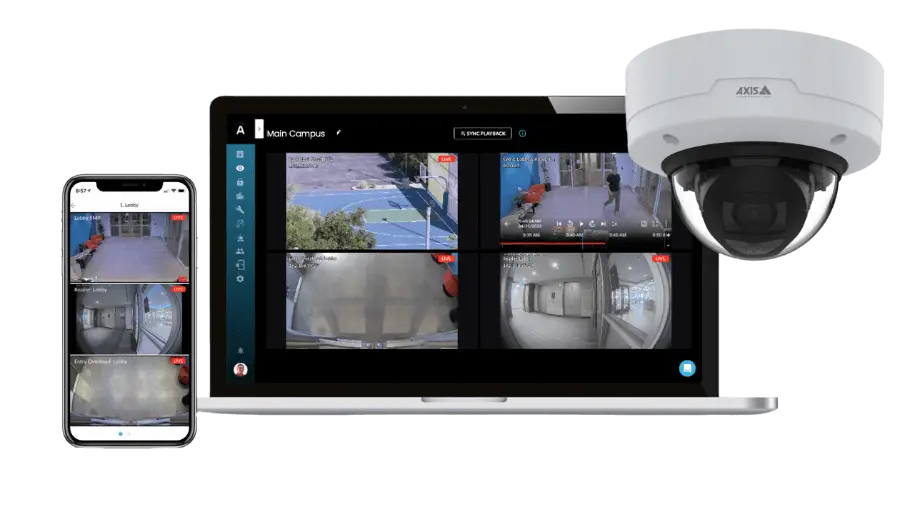This article discusses the unique capabilities and benefits of cloud-based video surveillance, how it works, and why the device-agnostic, cloud-based Arcules Video Surveillance as a Service (VSaaS) platform is the best choice for business and property owners seeking to transition from traditional to cloud-based surveillance systems.
What is Cloud Based Video Surveillance?
Cloud-based video surveillance is a modern approach to security that leverages cloud computing technology to store, manage, and analyze video footage. Unlike traditional on-premises systems, which rely on local storage devices such as Digital Video Recorders (DVRs) or Network Video Recorders (NVRs), cloud-based systems store video data in remote servers accessible via the internet.
In cloud-based video surveillance, video data is transmitted from cameras to cloud servers in real-time. These servers are typically located in data centers with robust security measures and redundancy protocols. This method of storage ensures that video data is protected from physical damage or theft that can affect on-premises systems. Additionally, cloud storage offers scalable options, allowing users to expand their storage capacity as needed without investing in additional hardware. Learn more about cloud-based data storage here.
Further, cloud-based video surveillance systems are designed to be highly compatible with a wide range of camera brands and existing infrastructure. This flexibility allows businesses to integrate cloud solutions with their current setups, minimizing the need for complete system overhauls. New cameras can be added to the system with minimal configuration, and existing cameras can often be connected with simple software updates or additional network components. This ease of integration reduces downtime and ensures a seamless transition from traditional to cloud-based surveillance.
The Role of AI in Enhancing Surveillance Capabilities
Perhaps the biggest draw for cloud-based video surveillance systems today is access to Artificial Intelligence (AI). AI plays a pivotal role in enhancing the capabilities of cloud-based video surveillance systems. AI-powered analytics can process video footage in real-time, identifying potential threats and alerting security personnel immediately.
AI in cloud-based surveillance systems offers advanced features such as facial recognition, anomaly detection, and behavior analysis. Facial recognition can identify individuals entering secure areas, while anomaly detection can highlight unusual activities or objects. Behavior analysis can predict potential security threats by analyzing movement patterns and interactions, allowing for proactive measures to be taken before incidents occur. Together these capabilities provide a level of surveillance accuracy that is difficult to achieve with human monitoring alone.
How Cloud-Based Video Surveillance Works

A typical cloud-based video surveillance system consists of several key components: cameras, cloud servers, and user interfaces. Cameras capture video footage and transmit it to cloud servers, where it is stored and analyzed. User interfaces, which can be accessed via web browsers or mobile apps, allow users to view live and recorded footage, configure system settings, and receive alerts. Key capabilities include:
- Versatile cloud storage options and retention policies. Cloud storage offers flexible options for data retention, allowing users to choose how long video footage is stored based on their specific needs – days, weeks, months, or indefinitely. Retention policies can be customized to comply with regulatory requirements or internal policies.
- Data redundancy and Disaster Recovery. Cloud-based surveillance systems are designed with data redundancy and disaster recovery features. Data is automatically backed up in multiple locations, ensuring that it remains accessible even if one server fails. In the event of a disaster, such as a fire or natural calamity, video footage can be quickly restored from backup servers, providing continuous protection.
- AI-driven analytics for pattern recognition and threat assessment. AI-driven analytics enhance the effectiveness of cloud-based video surveillance by recognizing patterns and assessing threats in real-time. These analytics can identify specific behaviors, such as loitering or unauthorized access, and trigger alerts for security personnel to investigate. This proactive approach allows for quicker response times and reduces the likelihood of security breaches.
- Automated incident reporting and analysis. AI can also automate incident reporting and analysis, providing detailed reports on security events. These reports can include video clips, timestamps, and descriptions of the detected anomalies, making it easier for security teams to review and respond to incidents. Automated analysis helps in identifying trends and improving overall security strategies.
Benefits of Cloud-Based Video Surveillance vs. On-Premises Systems
- Simplified installation and maintenance. Cloud-based video surveillance systems are easier to install than traditional on-premises systems. They require fewer hardware components, such as DVRs or NVRs, and less cabling – just power as data transmission is wireless. This simplified setup reduces the time and cost associated with installation, making it an attractive option for businesses of all sizes.
- Reduced need for onsite IT support and maintenance. Once installed, cloud-based systems require minimal onsite IT support and maintenance. Updates and security patches are typically managed by the cloud service provider, ensuring that the system remains up-to-date and secure without requiring constant attention or in-person visits to every camera by in-house IT teams. Read more about common causes of video signal loss in this article.
- Scalable and flexible. One of the key advantages of cloud-based video surveillance is the ability to expand coverage as needed without incurring substantial costs. Adding new cameras and locations to the system is straightforward and does not require significant changes to the existing infrastructure. DVRs and NVRs have a finite number of ports for hardwired camera connections, limiting scalability and requiring more hardware each time the current number of ports is exceeded.
- Manage multiple locations from a single platform. Cloud-based systems enable centralized management of multiple locations from a single platform. This feature is particularly beneficial for businesses with multiple sites, such as retail chains or corporate offices, as it allows security teams to monitor and manage all locations from one interface, improving efficiency and coordination.
- Enhanced Security. Cloud storage offers several security benefits. Beyond redundancy for DR purposes, cloud video surveillance service providers implement robust security measures such as encryption and access controls to protect data from unauthorized access and cyber threats. Automatic updates and security patches ensure that the system is always protected against the latest known vulnerabilities and reduce the burden on in-house IT teams, while data encryption assists with compliance regulations such as GDPR or HIPAA.
- Remote accessibility. Cloud-based video surveillance systems offer remote accessibility, allowing users to monitor live and recorded footage from any internet-enabled device. This feature provides flexibility and convenience, enabling security teams to keep an eye on their premises even when they are not physically present. On-premises systems are just that, with users limited to monitoring equipment in the building.
- Real-time alerts and notifications for immediate action. Alerts can be sent via email, SMS, or mobile app, notifying personnel of potential security incidents as they occur. Immediate notifications enable quick response times and help prevent security breaches before they escalate.
- Cost-effectiveness. The initial investment for cloud-based video surveillance is typically lower than that for traditional systems. With fewer hardware requirements and no need for DVRs or NVRs, businesses save on upfront costs. Since the cloud service provider handles most updates and maintenance tasks, businesses can avoid the high costs associated with hardware replacements and system upgrades. Additionally, the pay-as-you-go pricing model of many cloud services allows for more predictable budgeting.
The Future of Video Surveillance: Cloud + AI
The adoption of cloud-based video surveillance solutions is expected to continue growing rapidly. Businesses across various industries are recognizing the benefits of cloud technology, leading to increased investment in cloud-based systems. Future advancements in AI-driven surveillance capabilities are expected to further enhance security and efficiency. By identifying potential security threats before they escalate, AI can help prevent incidents and reduce the risk of harm. This proactive approach is transforming the way various industries approach security, making it more dynamic and responsive.
- In healthcare, cloud-based surveillance can enhance patient safety, protect sensitive areas, and ensure compliance with regulations. Hospitals and clinics can benefit from AI-driven analytics to monitor patient behavior, detect anomalies, and prevent incidents such as patient falls or unauthorized access to restricted areas.
- In education, schools and universities can utilize cloud-based systems to enhance campus security, monitor student activity, and respond swiftly to emergencies. The ability to manage multiple locations from a single platform is particularly beneficial for large educational institutions with multiple campuses.
- In commercial real estate, property managers can use cloud-based surveillance to monitor building security, manage access control, and provide a safer environment for tenants. The scalability of cloud systems allows for easy expansion as new properties are acquired or developed.
- In logistics, warehouses and distribution centers can leverage cloud-based surveillance to improve inventory management, monitor employee activity, and prevent theft. AI-driven analytics can help identify inefficiencies in operations and enhance overall productivity.
Enhance Your Security with Cloud-based video surveillance from Arcules

Cloud-based video surveillance offers numerous benefits over traditional on-premises systems, including simplified installation and maintenance, scalability, enhanced security, remote accessibility, and cost-effectiveness. It is a superior choice for large-scale and multi-site implementations. The integration of AI enhances cloud-based systems further by providing advanced analytics, real-time threat detection, and automated incident reporting.
When selecting a cloud-based video surveillance system and provider, it is essential to consider several factors such as compatibility with existing hardware, the level of desired AI integration, data security measures, scalability, and overall cost.
The Arcules VSaaS platform supports over 6,000 types of cameras, alarms, and access control systems, eliminating switching costs and ensuring a smooth transition from legacy technology. Arcules removes the need and cost for on-premises hardware and video storage, offers a wide range of AI-powered tools for real-time video analytics, and reduces risk through its affordable subscription model.
Looking to migrate your on-premises surveillance to the cloud? Look to Arcules. Click here to learn more and schedule a no-obligation consultation.
